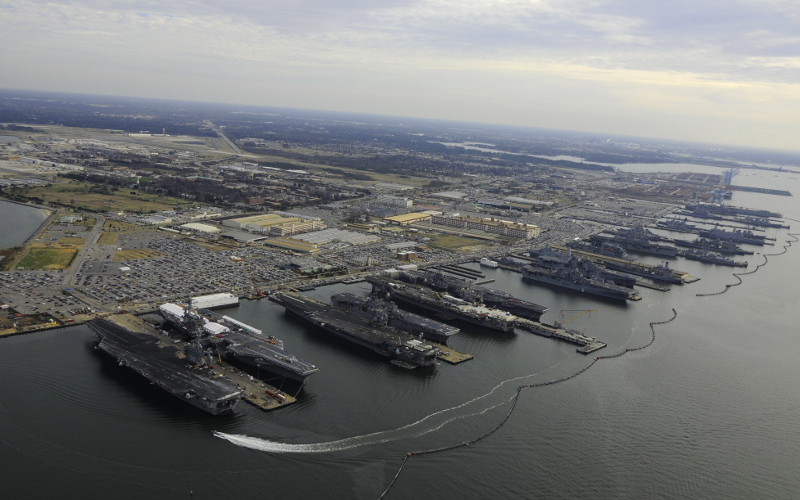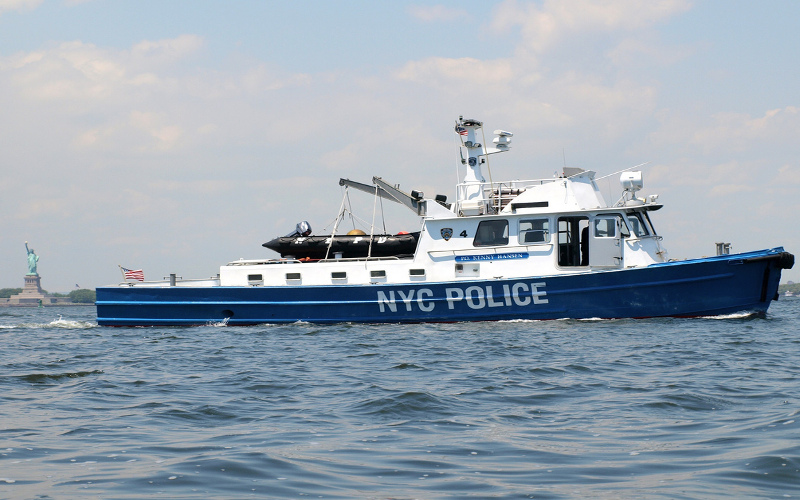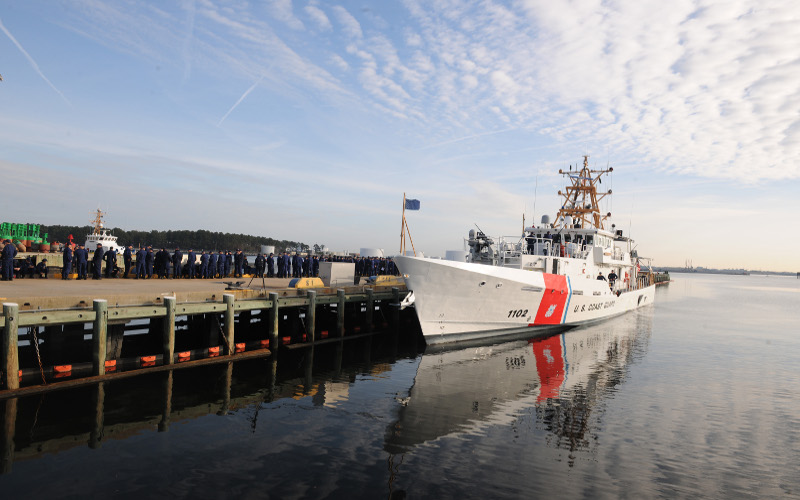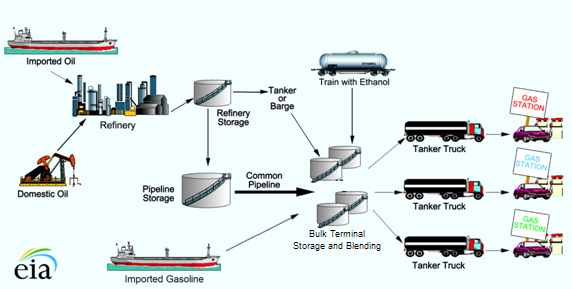Project Description
Project Name
Coastal Installation Microgrid Study
Location
Eastern Seaboard, US
Challenge
Installation-Wide Microgrid
Description:
Many maritime facilities are exposed to escalating risk related to electric grid reliability, particularly during natural disasters and extreme weather events – the very time when electrical grid vulnerabilities are often exposed the most. Missions of these federal, state, and local installations are to secure and manage our borders, prevent terrorism, perform rescue operations, and enforce maritime law regardless of weather conditions or availability of grid power. Uncertainty about mission uptime during extreme weather events led one facility to consider microgrid strategies for providing energy security and resiliency to enhance critical missions and operations throughout the year. This installation is typical of the many facilities located in light industrial settings scattered throughout the Mid-Atlantic area of the eastern U.S. coastline.
Goals such as those set by the U.S. Navy to produce at least 50 percent of their shore-based energy requirements from renewable sources by 2020 are excellent efforts in terms of reducing greenhouse gases. However, if not integrated into a master-planned system, many renewable energy systems simply do not function during widespread grid outages.
The focus of this study was to go beyond standalone renewable generation systems by quantifying the economic and operational impacts of integrating disparate renewable energy generation systems into durable microgrids to improve the resiliency of utility infrastructure and enhance mission readiness. The approach taken was to develop costs, based on multiple iterations of a coastal microgrid design, for construction, ownership, operation, and maintenance of the renewable and energy surety systems and integrate into a Microgrid as a Service (Maas) monthly fee based service, much like a utility’s billing structure.
Such an approach enables the full monetization and utilization of renewable energy tax credits and grants. The MaaS structure also allows potential ancillary services payments from the installation’s electric utility or Regional Transmission Operator (RTO) to be leveraged to produce a lower levelized cost of energy (LCOE). Issues that most governmental entities face is that they are not able to take advantage of tax incentives since they don’t actually have a tax bill to take deductions against. Another challenge that governmental agencies can face is the inability to receive direct payments from third-parties at the installation level. Oftentimes, payments such as one from an RTO as compensation for participating in an ancillary services program such as Frequency Regulation, can only be received by a central treasury or comptroller-like function/agency. Allowing asset ownership to reside with a tax-paying private sector entity enables governments to receive pass-through benefits related to the items described above.
Electric utility energy supply, distribution, and commercial structures will continue to undergo significant transformation as renewable penetration, grid congestion, and aging transmission infrastructure drive fundamental market changes. An initial focus of the report was to evaluate high-level microgrid architectures and assess the fundamental benefits provided to both mission resiliency and lifecycle costs.
The flip charts below illustrate generic differences between two different microgrid approaches. Primary goals of the study were; 1) to focus on strategies that would minimize added energy security costs relative to current energy costs, and 2) to quantify how potential future cost and efficiency changes to renewable generation and energy storage technologies might impact future LCOEs for various microgrid architectures.
Department of Energy

Grid Interactive
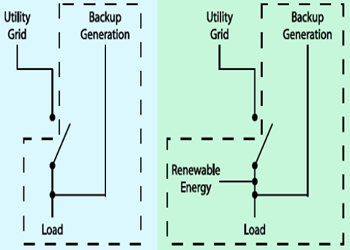
Microgrid Definitions
Differing Functionality Affects Fundamental Design
Department of Defense
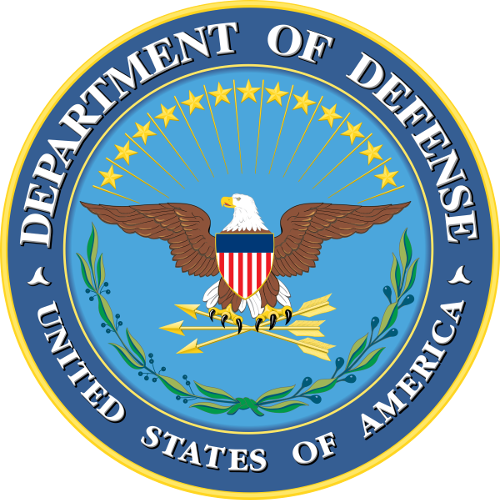
Non-Grid Interactive
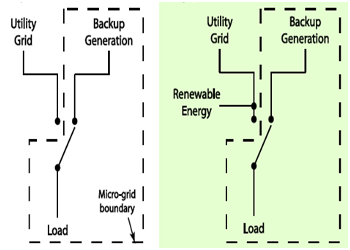
Fuel diversification is a critical component that allows microgrids to maintain high levels of availability during extended islanding or grid outage events. The combination of multi-source, multi-unit, and multi-fuel generation units as part of a comprehensive microgrid strategy enhance resiliency. Weather events often disrupt fuel supplies and create shortages that limit run-times of generators, necessitating the need to shed electrical load.
The fuel oil supply chain has five main parts: producing or importing crude oil; importing fuel oil; refining the crude oil into fuel oil; blending fuel oil as necessary at distribution terminals; and selling the fuel oil at retail stations. Between each part, various storage and distribution logistics steps are involved to move and store both crude and fuel oil. Disruptions can affect any part of the supply chain, and during major disruptions such as hurricanes or power outages, the Department of Energy issues situation reports to provide information about a disruption’s effect on fuel oil supply and other energy infrastructure and supply.
Extending Islanding Durations through Fuel Supply Chain Contingency Planning
Typical standby generators run on diesel fuel oil, and given that many ships also operate on diesel fuel, many maritime-based installations have a unique contingent capability to store fuel in their own vessels.
Oftentimes, by virtue of their own fleets, these types of facilities also possess unique transportation capabilities to maintain fuel supply chain continuity to support shore operations.
Natural gas supplies are typically very reliable and unaffected by most natural disasters and significant weather events. Underground distribution and storage for this fuel type provide significant protection during weather catastrophes and typically are the fuel of choice for microgrids. Using both natural gas and a multi-tiered diesel delivery capability for maritime microgrids can enable very high assurance levels with regard to fuel supply during long-term grid outages.
Given a facility’s inability to shed load during an extended grid outage, the only reliable means of extending islanding durations is to ensure replenishment or continuation of fuel supply. For this reason, it is important to look beyond the equipment that comprises a microgrid to ensure that operational enablers such as reliable fuel supplies are not ignored or overlooked.
Evaluated Homeland Security Microgrid Features and Attributes
- Microgrid as a Service Commercial Structure
- Ancillary Services Market Participation
- Reciprocating Engines (Natural Gas & Diesel)
- Combustion Turbines
- Micro-Turbines
- Wind Turbines (Horizontal & Vertical Axis)
- Solar Photovoltaic (Crystalline & Thin Film)
- Aggregation of Existing Standby Diesel Fleet
- Fuel Supply Chain Contingent Strategies
- Fuel Cells (BloomBox)
- BioPower (Landfill Gas / MSW / Biogas)
- Battery Storage (Li-ion / Na-S / VR / Zn-Br )
- Thermal Energy Storage (TES)
- Kinetic Energy Storage (Flywheels)


